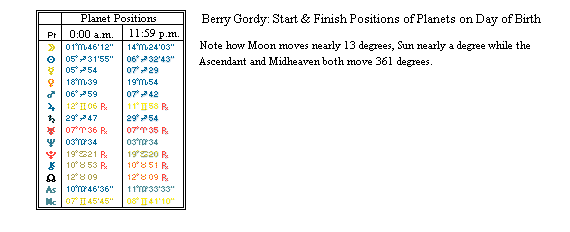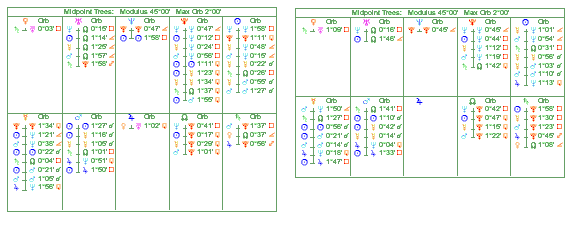as illustrated below a midpoint is, as it sounds, the halfway point between two points in a chart.
There are two direct midpoints, which are found through bisecting the shortest arc and (less
logically) the longer arc between these.

In the middle illustration the midpoint has been moved to the bottom of the circle in an effort to keep the
reader alert. This diagram shows all the positions a planet could be what is termed 'on' this midpoint. There are actually eight positions, since the planet could also be at the same degree as the midpoint, i.e.
conjunct it. If the Sun were at any of these eight points it would be on JU/UR. The conventions of notating this are shown
on the right.
When using midpoints, it is usual to consider a horoscope factor on a midpoint when the aspect
from such an object
to the midpoint is exact to no more than 1.5 degrees. With the Sun a greater leeway or orb
of 2 degrees is allowed, which is also the case with the Moon, Midheaven and Ascendant.
Any midpoint containing two factors from this group of Sun, Moon, Ascendant and Midheaven also
has an orb of 2 degrees to the less powerful factors in the chart. Thus 2 degree orbs are allowed for
combinations such as Sun=Jupiter/Pluto and Mercury=Moon/Midheaven.
These important midpoint rules are radically simplified in our present case:
the Sun has a 2 degree orb, everything else 1.5 degrees.
This is because all other 2 degree factors can't be looked at since we don't know their positions.
Using such small orbs it is vital that we are aware of the movement of all our chart
factors during the day of birth. A mental picture of what this entails can be come upon through consideration of the chart below.

'Midpoint Trees' are constructed when midpoints and other chart factors are put in order using what has effectively
become a 45 degree stretch of zodiac. They provide detail of planetary themes grouped around each chart factor
and so give amazing detail of exactly 'what sort' of Venus or Jupiter, for example a person has.
An excellent source for greater depth on what midpoints mean and how we can use them can be found in Harvey and Harding's
Working with Astrology.
Illustrated below are midpoint trees for Berry Gordy at the start (left) and end of his day of birth set for the
appropriate time zone in Detroit. Remember: the Sun tree has that magic 2 degree orb, every other tree 1.5 degrees.
Scanning and comparing trees we can see which planets remained on midpoints all day and look for themes.

Thus we can see which midpoint messages come out of this chart. Here are a few of the important ones: -
* Pluto and the Sun were on Mars/Neptune all day, Mercury was on Mars/Neptune much of the day.
* Sun and Mercury are on Saturn/Node, as, for much of the time, is Mars, .
* Venus is on the important Saturn/Uranus midpoint
* Jupiter/Neptune is on Mars all day, and by the end of the day it has moved onto the Sun and Mercury.
With this knowledge we can go to our midpoint books - principly Ebertin's COSI, though it is also worth looking
at other sources, to consider what the patterns tell us.
For Mars/Neptune COSI gives a generally negative interpretation - the combination has a strong reputation for
seduction and misplaced energy. Yet Gordy seems to have found an excellent outlet for this seductive, subtle energy
in music and songwriting.
Saturn/Node is seen as concerning 'inhibition in unions or associations' by Ebertin. Yet the point also concerns
working (Saturn) with groups (Node) who are underprivileged (Saturn). Mars here, says COSI, concerns 'The
desire to gain release from depression' a theme of the blues that were Berry Gordy's early inspiration and which
he helped translate into a more modern form.
Venus=Saturn/Uranus is given in COSI as 'Tensions or stresses in love-life often leading to separation.'
Anything on this contradictory and tense midpoint has to work within the tensions of tradition and caution versus
the desire for progression and rebellion.
Working with midpoints through using COSI will sharpen up your understanding of astrology a great deal.
Don't be put off if it seems a little complex at first - using midpoints soon becomes second nature and opens up
a whole new understanding of astrology.
continue reading





